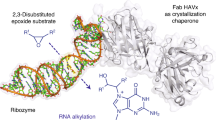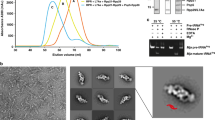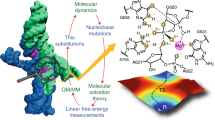Abstract
The hairpin ribozyme catalyses sequence-specific cleavage of RNA. The active site of this natural RNA results from the docking of two irregular helices: stems A and B. One strand of stem A harbours the scissile bond. The 2.4 Å resolution structure of a hairpin ribozyme–inhibitor complex reveals that the ribozyme aligns the 2′-OH nucleophile and the 5′-oxo leaving group by twisting apart the nucleotides that flank the scissile phosphate. The base of the nucleotide preceding the cleavage site is stacked within stem A; the next nucleotide, a conserved guanine, is extruded from stem A and accommodated by a highly complementary pocket in the minor groove of stem B. Metal ions are absent from the active site. The bases of four conserved purines are positioned potentially to serve as acid-base catalysts. This is the first structure determination of a fully assembled ribozyme active site that catalyses a phosphodiester cleavage without recourse to metal ions.
This is a preview of subscription content, access via your institution
Access options
Subscribe to this journal
Receive 51 print issues and online access
$199.00 per year
only $3.90 per issue
Buy this article
- Purchase on Springer Link
- Instant access to full article PDF
Prices may be subject to local taxes which are calculated during checkout





Similar content being viewed by others
References
Fedor, M. J. Structure and function of the hairpin ribozyme. J. Mol. Biol. 297, 269–291 (2000).
McKay, D. B. & Wedekind, J. E. in The RNA World (eds Gesteland, R. F., Cech, T. R. & Atkins, J. F.) 265–286 (Cold Spring Harbor Press, Cold Spring Harbor, 1999).
Butcher, S. E., Heckman, J. E. & Burke, J. M. Reconstitution of hairpin ribozyme activity following separation of functional domains. J. Biol. Chem. 270, 29648–29651 (1995).
Shin, C. et al. The loop B domain is physically separable from the loop A domain in the hairpin ribozyme. Nucleic Acids Res. 24, 2685–2689 (1996).
Murchie, A. I. H., Thomson, J. B., Walter, F. & Lilley, D. M. J. Folding of the hairpin ribozyme in its natural conformation achieves close physical proximity of the loops. Mol. Cell 1, 873–881 (1998).
Walter, N. G., Burke, J. M. & Millar, D. P. Stability of hairpin ribozyme tertiary structure is governed by the interdomain junction. Nature Struct. Biol. 6, 544–549 (1999).
Walter, F., Murchie, A. I. H., Thomson, J. B. & Lilley, D. M. J. Structure and activity of the hairpin ribozyme in its natural junction conformation: effect of metal ions. Biochemistry 37, 14195–14203 (1998).
Hampel, A. & Cowan, J. A. A unique mechanism for RNA catalysis: the role of metal cofactors in hairpin ribozyme cleavage. Chem. Biol. 4, 513–517 (1997).
Nesbitt, S., Hegg, L. A. & Fedor, M. J. An unusual pH-independent and metal-ion independent mechanism for hairpin ribozyme catalysis. Chem. Biol. 4, 619–630 (1997).
Young, K. J., Gill, F. & Grasby, J. A. Metal ions play a passive role in the hairpin ribozyme catalyzed reaction. Nucleic Acids Res. 25, 3760–3766 (1997).
Cowan, J. A. Metallobiochemistry of RNA. Co(NH3)3+6 as a probe for Mg2+ (aq) binding sites. J. Inorg. Biochem. 49, 171–175 (1993).
Ferré-D'Amaré, A. R., Zhou, K. & Doudna, J. A. Crystal structure of a hepatitis delta virus ribozyme. Nature 395, 567–574 (1998).
Perrotta, A. T., Shih, I. & Been, M. D. Imidazole rescue of a cytosine mutation in a self-cleaving ribozyme. Science 286, 123–126 (1999).
Nakano, S. -I., Chadalavada, D. M. & Bevilacqua, P. C. General acid-base catalysis in the mechanism of a hepatitis delta virus ribozyme. Science 287, 1493–1497 (2000).
Muth, G. W., Ortoleva-Donnelly, L. & Strobel, S. A. A single adenosine with a neutral pKa in the ribosomal peptidyl transferase center. Science 289, 947–950 (2000).
Chowrira, B. M. & Burke, J. M. Binding and cleavage of nucleic acids by the “hairpin” ribozyme. Biochemistry 30, 8515–8522 (1991).
Walter, N. G., Hampel, K. J., Brown, K. M. & Burke, J. M. Tertiary structure formation in the hairpin ribozyme monitored by fluorescence resonance energy transfer. EMBO J. 17, 2378–2391 (1998).
Nowakowski, J., Shim, P. J., Prasad, G. S., Stout, C. D. & Joyce, G. F. Crystal structure of an 82-nucleotide RNA-DNA complex formed by the 10-23 DNA enzyme. Nature Struct. Biol. 6, 151–156 (1999).
Walter, F., Murchie, A. I. H. & Lilley, D. M. J. Folding of the four-way RNA junction of the hairpin ribozyme. Biochemistry 37, 17629–17636 (1998).
Hampel, K. J., Walter, N. G. & Burke, J. M. The solvent-protected core of the hairpin ribozyme-substrate complex. Biochemistry 37, 14672–14682 (1998).
Earnshaw, D. J. et al. Inter-domain cross-linking and molecular modeling of the hairpin ribozyme. J. Mol. Biol. 274, 197–212 (1997).
Cai, Z. & Tinoco, I. J. Solution structure of loop A from the hairpin ribozyme from tobacco ringspot virus satellite. Biochemistry 35, 6026–6036 (1996).
Butcher, S. E., Allain, F. H. -T. & Feigon, J. Solution structure of the loop B domain from the hairpin ribozyme. Nature Struct. Biol. 6, 212–216 (1999).
Chowrira, B. M., Berzal-Herranz, A. & Burke, J. M. Novel guanosine requirement for catalysis by the hairpin ribozyme. Nature 354, 320–322 (1991).
Moore, P. B. Structural motifs in RNA. Annu. Rev. Biochem. 68, 287–300 (1999).
Butcher, S. E. & Burke, J. M. A photo-cross-linkable tertiary structure motif found in functionally distinct RNA molecules is essential for catalytic function of the hairpin ribozyme. Biochemistry 33, 992–999 (1994).
Ferré-D'Amaré, A. R. & Doudna, J. A. Crystallization and structure determination of a hepatitis delta virus ribozyme: use of the RNA-binding protein U1A as a crystallization module. J. Mol. Biol. 295, 541–556 (2000).
Schmidt, S. et al. Base and sugar requirements for RNA cleavage of essential nucleoside residues in internal loop B of the hairpin ribozyme: implications for secondary structure. Nucleic Acids Res. 24, 573–581 (1996).
Walter, N. G., Yang, N. & Burke, J. M. Probing non-selective cation binding in the hairpin ribozyme with Tb(III). J. Mol. Biol. 298, 539–555 (2000).
Butcher, S. E., Allain, F. H. -T. & Feigon, J. Determination of metal ion binding sites within the hairpin ribozyme domains by NMR. Biochemistry 39, 2174–2184 (2000).
Wu, M. & Tinoco, I. RNA folding causes secondary structure rearrangement. Proc. Natl Acad. Sci. USA 95, 11555–11560 (1998).
Chowrira, B., Berzal-Herranz, A., Keller, C. F. & Burke, J. M. Four ribose 2′-hydroxyl groups essential for catalytic function of the hairpin ribozyme. J. Biol. Chem. 268, 19458–19462 (1993).
Ryder, S. P. & Strobel, S. A. Nucleotide analog interference mapping of the hairpin ribozyme: implications for secondary and tertiary structure formation. J. Mol. Biol. 291, 295–311 (1999).
Young, K. J. et al. The role of essential pyrimidines in the hairpin ribozyme-catalysed reaction. J. Mol. Biol. 288, 853–866 (1999).
Pinard, R. et al. Structural basis for the guanosine requirement of the hairpin ribozyme. Biochemistry 38, 16035–16039 (1999).
Siwkowski, A., Shippy, R. & Hampel, A. Analysis of hairpin ribozyme base mutations in loops 2 and 4 and their effects on cis-cleavage in vitro. Biochemistry 36, 3930–3940 (1997).
Shippy, R., Siwkowski, A. & Hampel, A. Mutational analysis of loops 1 and 5 of the hairpin ribozyme. Biochemistry 37, 564–570 (1998).
Grasby, J. A., Mersmann, K., Singh, M. & Gait, M. J. Purine functional groups in essential residues of the hairpin ribozyme required for catalytic cleavage of RNA. Biochemistry 34, 4068–4076 (1995).
van Tol, H., Buzayan, J. M., Feldstein, P. A., Eckstein, F. & Bruening, G. Two autolytic processing reactions of a satellite RNA proceed with inversion of configuration. Nucleic Acids Res. 18, 1971–1975 (1990).
Richards, F. M. et al. Protein structure, ribonuclease-S, and nucleotide interactions. Cold Spring Harbor Symp. Quant. Biol. 36, 35–43 (1971).
Findlay, D., Herries, D. G., Mathias, A. P., Rabin, B. R. & Ross, C. A. The active site and mechanism of action of bovine pancreatic ribonuclease 7. The catalytic mechanism. Biochem. J. 85, 152–153 (1962).
Roberts, G. C. K., Dennis, E. A., Meadows, D. H., Cohen, J. S. & Jardetzky, O. The mechanism of action of ribonuclease. Proc. Natl Acad. Sci. USA 62, 1151 (1969).
Kleywegt, G. J. & Jones, T. A. Detection, delineation, measurement and display of cavities in macromolecular structures. Acta Crystallogr. D 50, 175–177 (1994).
Fedor, M. J. Tertiary structure stabilization promotes hairpin ribozyme ligation. Biochemistry 38, 11040–11050 (1999).
Saenger, W. Principles of Nucleic Acid Structure (Springer, New York, 1984).
Ferré-D'Amaré, A. R. & Doudna, J. A. Use of cis- and trans-ribozymes to remove 5′ and 3′ heterogeneities from milligrams of in vitro transcribed RNA. Nucleic Acids Res. 24, 977–978 (1996).
Otwinowski, Z. & Minor, W. Processing of X-ray diffraction data collected in oscillation mode. Methods Enzymol. 276, 307–326 (1997).
Brünger, A. T. et al. Crystallography and NMR system: a new software system for macromolecular structure determination. Acta Crystallogr. D 54, 905–921 (1998).
Jones, T. A., Zou, J. Y., Cowan, S. W. & Kjeldgaard, M. Improved methods for building protein models in electron density maps and the location of errors in these models. Acta Crystallogr. A 47, 110–119 (1991).
Carson, M. Ribbons. Methods Enzymol. 277, 493–505 (1997).
Acknowledgements
We thank T. Earnest, L. Hung and G. McDermott for help at ALS beamline 5.0.2; C. Hoang for biochemical support; J. Bolduc, P. Heath and B. Shen for computational and crystallographic support; K. Nagai for U1A plasmids; and S. Biggins, M. Holmes, P. Li, M. Rosenberg, S. Ryder, S. Sigurdsson, B. Stoddard, S. Strobel, R. Strong, G. Varani, D. Wilson and K. Zhang for discussions. This work was supported by institutional funds from the Fred Hutchinson Cancer Research Center (FHCRC). Access to ALS beamline 5.0.2 as part of the principal research consortium was made possible by general support from the FHCRC. P.B.R. is a post-doctoral trainee of the Chromosome Metabolism and Cancer training grant from the National Cancer Institute to the FHCRC.
Author information
Authors and Affiliations
Corresponding author
Supplementary information

Figure 1.
Single turnover cleavage assay. End-labeled substrate RNA (200 nM) was incubated with ribozyme (1 m M) in reaction buffer (1 mM MgCl2, and 50 mM Tris pH 7.5) at 25°C for the times indicated. Reactions were resolved on a 20% polyacrylamide, 8M urea gel. The substrate RNA has the same sequence as the inhibitor strand used in the crystals but is all-ribose. It was incubated with either a wild-type four-helix junction ribozyme, or the crystallization construct with and without U1A-RBD. Reactions do not go to completion because the ribozymes also catalyze ligation.

Figure 2.
Stereoview of a portion of the 2.4 쎅 resolution ‘solvent-flattened’ experimental electron density map represented as blue and red mesh. The contour levels are one and three s.d. above the mean peak height, respectively. Superimposed on the density is the refined model of the active site oriented as in Fig. 5d.

Figure 3.
Stereoview of a portion of the sA-weighted simulated-annealing omit 2|Fo| -|Fc| electron density map. The contour levels, colors, and superimposed model are the same as in the previous figure.
Rights and permissions
About this article
Cite this article
Rupert, P., Ferré-D'Amaré, A. Crystal structure of a hairpin ribozyme–inhibitor complex with implications for catalysis. Nature 410, 780–786 (2001). https://doi.org/10.1038/35071009
Received:
Accepted:
Issue Date:
DOI: https://doi.org/10.1038/35071009
This article is cited by
-
Crystal structure of an RNA-cleaving DNAzyme
Nature Communications (2017)
-
Pressure modulates the self-cleavage step of the hairpin ribozyme
Nature Communications (2017)
-
Pistol ribozyme adopts a pseudoknot fold facilitating site-specific in-line cleavage
Nature Chemical Biology (2016)
-
Ribozymes and the mechanisms that underlie RNA catalysis
Frontiers of Chemical Science and Engineering (2016)
-
Crystal structure of the Varkud satellite ribozyme
Nature Chemical Biology (2015)
Comments
By submitting a comment you agree to abide by our Terms and Community Guidelines. If you find something abusive or that does not comply with our terms or guidelines please flag it as inappropriate.



